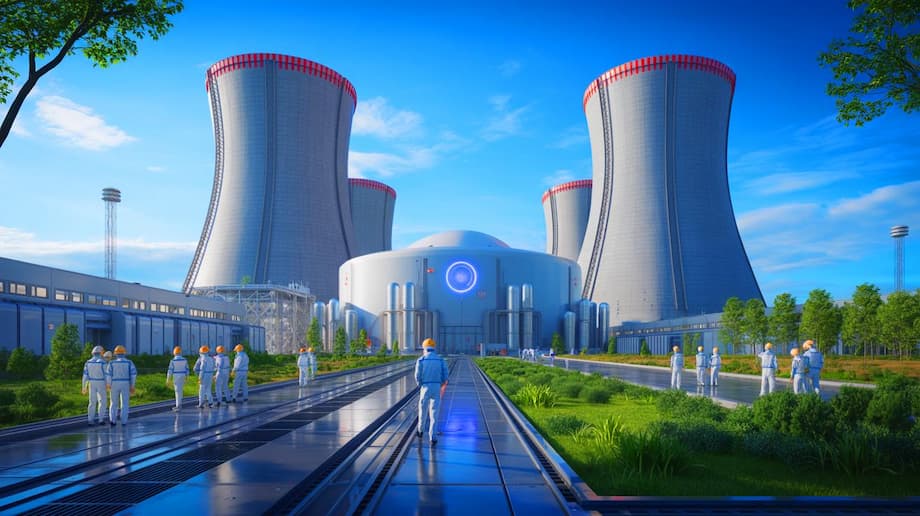A leap in reactor design with global stakes
China has moved a large step closer to commercial fast reactor power. The China National Nuclear Corporation has presented the design of the CFR 1000, a fast neutron power plant rated up to 1.2 gigawatts. Pending safety approvals, CNNC targets operation in the early 2030s, with 2034 widely cited as a planning date. That output, in the range of one million homes, would make the unit one of the largest advanced reactors under development.
- A leap in reactor design with global stakes
- How a fast neutron reactor makes energy
- Why liquid sodium is central to the design
- Safety questions for regulators
- Chinas roadmap, from experiment to commercial scale
- Fuel cycle, waste and nonproliferation
- How the project fits into the global race
- Economics and the role on the Chinese grid
- Regulatory path and timeline
- Key Points
Unlike the pressurized water reactors that form the backbone of todays nuclear fleets, the CFR 1000 does not slow neutrons with a moderator such as water. It is a fast neutron reactor. The design is part of a class often grouped under fourth generation systems, which aim for better fuel use, lower waste and strong safety features. CNNC positions the CFR 1000 as the first commercial step in a staged plan that began with a small experimental unit and a pair of demonstration plants now under construction. The company presented the design at a symposium on advanced nuclear energy in Fuzhou in Fujian Province, with energy authorities in attendance.
Interest extends far beyond Chinas borders. A commercial fast reactor at this scale could change how countries plan for energy security and climate goals. It could also renew debate about fuel recycling, plutonium management, and trade in nuclear materials. Regulators in China will set the pace. Peers abroad will watch how the design performs while they advance their own fast reactor programs.
The CFR 1000 uses liquid sodium in place of water to move heat from the core to power generating equipment. Sodium allows higher operating temperatures at low pressure, which improves thermal efficiency and reduces some accident mechanisms seen in water cooled systems. That choice also brings specific engineering challenges. Sodium reacts with water and air, so the plant design relies on sealed environments, leak detection, and multiple heat transfer loops to isolate the metal from steam and the atmosphere.
How a fast neutron reactor makes energy
At the center of any reactor is a chain reaction. In a conventional plant, fuel rods sit in water that serves several roles. Water moderates, or slows, neutrons so they are more likely to split uranium 235. It also cools the fuel and carries heat to the steam generators. A fast reactor removes the moderator from the picture. Neutrons remain at higher energy and can split a wider set of nuclei, including plutonium isotopes that form in the fuel.
This change has several effects. Fuel can be used more completely before it is spent. The neutron rich environment supports a closed fuel cycle, where the reactor breeds new fissile material from abundant uranium 238. When that fresh material is separated and recycled, the same atoms can support power generation multiple times. The process can also consume some long lived waste from conventional reactors, trimming the long term waste burden if the entire cycle is deployed at scale.
Breeding, reprocessing and the closed cycle
Breeding refers to creating new fissile fuel inside the reactor. In a typical setup, uranium 238 captures a neutron and, through a series of decays, becomes plutonium 239. When designers surround the core with blankets of fertile material, the plant can produce enough new fuel to replace what the core consumes. That ratio, the breeding ratio, determines how much fresh material is available for the next fuel load.
To close the cycle, fuel must be reprocessed. China has pilot and demonstration scale reprocessing efforts and has explored industrial projects with partners. Mixed oxide fuel, a blend of plutonium and uranium, has been used in fast reactors and also in some conventional plants. CNNC has also pointed to metal fuel for later stages of its program. Each option comes with tradeoffs in performance, materials handling, and the complexity of the recycling step.
Why liquid sodium is central to the design
Liquid sodium is a favorite coolant for fast reactors because it does not slow neutrons and it carries heat very well. It stays liquid over a wide temperature range and it boils at a very high temperature, so the reactor can run at near atmospheric pressure. Running at low pressure reduces the stress on pipes and vessels and removes the risk of large steam explosions that drive some accident scenarios in water cooled plants.
The CFR 1000 will use a pool type layout according to public descriptions of Chinese projects in this line. The core, pumps and heat exchangers sit in a large vessel of sodium. Heat moves from the primary sodium loop to a secondary sodium loop, then to a water or supercritical carbon dioxide system that drives the turbines. This three stage approach is designed to keep any steam leaks far from the radioactive primary loop.
Handling sodium safely
Sodium handling is a key discipline for this kind of plant. The metal reacts with water and oxygen. Designers address that with sealed cover gas systems, typically argon, air free enclosures, rapid leak detection, and equipment that keeps oxygen content in sodium extremely low to limit corrosion. Steam generators are built with materials that resist attack and with monitoring that can detect a tiny transfer of hydrogen long before a tube breaks.
Fire protection looks different than in a water plant. Operators plan for sodium spills that can smoke or burn if exposed to air. Inerted rooms, drip trays, and special fire suppression agents are standard practices from past plants in Russia, France, Japan and the United States. The global track record includes lessons from incidents, and modern designs try to include that experience in layouts and operating procedures.
Safety questions for regulators
Fast reactors use physics that differ from conventional units, which leads regulators to focus on a few recurring questions. One is how the reactor behaves if coolant boils or if flow is lost. Designers work to secure a strong negative reactivity response so the chain reaction slows as temperatures rise. Another priority is decay heat removal for many days without operator action. Modern fast designs include passive systems that rely on natural convection and heat exchangers immersed in the coolant.
Sodium water reactions are another focus. Even with separate loops, a leak in a steam generator can spray water into hot sodium. That produces heat and hydrogen. Plants are built with small diameter tubes, isolation valves that shut quickly, and dump tanks that can remove sodium from the generator in seconds. These steps reduce the chance of tube failure and limit consequences if one fails.
CNNC has said the technology meets fourth generation goals in safety, waste, and economics. The Chinese regulator will test those claims in a formal licensing review. Experience from the China Experimental Fast Reactor, a 20 megawatt electric unit near Beijing, and from the CFR 600 demonstration units in Fujian, will feed into the safety case for the larger plant. International experts will watch the process and compare it to their own standards.
Chinas roadmap, from experiment to commercial scale
Fast reactor work in China dates to the 1960s. The China Experimental Fast Reactor reached first criticality in 2010 and achieved a series of power tests over the next few years, including sustained full power operation. It serves research goals and connects to the grid at times. The next step has been the CFR 600, a pair of demonstration units in Xiapu County in Fujian Province. Equipment and fuel supply for those units have included cooperation with Russian firms.
Public planning documents describe the CFR 1000 as the commercial stage. World Nuclear Association material indicates construction could begin before the end of this decade, with operations around 2034. CNNC has said it has built a domestic supply chain for large fast reactors, covering design codes, safety analysis tools, equipment manufacturing, fuel fabrication and project management. The company has not disclosed a final site for the first CFR 1000.
Program material points to metal fuel in the commercial stage with target burnup on the order of 120 to 150 gigawatt days per ton. That compares to typical values lower in thermal plants. Higher burnup reduces refueling frequency, lowers the mass of spent fuel per unit of electricity, and uses uranium resources more fully.
The roadmap mirrors a three step strategy often cited by Chinese officials. First, thermal reactors based on pressurized water deliver capacity at scale. Second, fast reactors increase fuel efficiency and set up a closed cycle. Third, fusion becomes part of the mix over a longer horizon. The fast reactor stage aims to stretch uranium resources, reduce the burden on waste repositories, and add flexible industrial heat and isotope production options.
Fuel cycle, waste and nonproliferation
Reprocessing spent fuel to extract usable material is central to the fast reactor pitch on waste. By separating plutonium and the remaining uranium, and by routing long lived actinides back into the core, the system can reduce the volume and radiotoxicity of material headed for deep disposal. That picture depends on industrial scale plants for separation and on fuel fabrication lines that can handle fresh mixes and higher radiation fields.
China has operated pilot reprocessing lines and has explored large projects with international partners. The country already fabricates MOX fuel and is developing metal fuel capabilities that match later stage fast reactor cores. Each step is subject to safeguards under the Nuclear Non Proliferation Treaty. Inspectors account for special nuclear material and verify that fuel is used for energy, not for weapons.
Nonproliferation debates often center on plutonium. Fast reactors can produce high quality plutonium 239. That fact does not make a power program a weapons program, but it does require robust accounting, physical protection, and a strong policy framework. Chinas supply deals with Russian partners for enriched fuel and technology have also drawn scrutiny abroad, given broader geopolitical tensions. Transparent reporting and engagement with international bodies will be part of any plan to expand this fleet.
How the project fits into the global race
China is not alone in returning to fast reactors. Russia runs the BN 800 at Beloyarsk and is developing a larger BN 1200 unit with a target similar to 1.2 gigawatts. India has pursued a 500 megawatt fast breeder at Kalpakkam with a strategy that uses thorium later in the cycle. France and Japan built and then shut several plants after technical setbacks and cost pressure. The United States closed its Integral Fast Reactor program in the 1990s and does not operate a power producing fast reactor today.
New designs are advancing. TerraPower and GE Hitachi are building a sodium cooled reactor in Wyoming that pairs a 345 megawatt nuclear unit with molten salt energy storage to deliver flexible output. Several private firms in Europe, Japan and North America are targeting designs that use liquid lead, supercritical carbon dioxide turbines, and other innovations. Many of these projects aim for small modular units, while China and Russia are leaning toward gigawatt class plants.
These programs reflect a split in priorities. Some teams are chasing lower costs and simple construction with smaller units. Others see value in very high output plants that replace large coal units and that match heavy industry demand. The outcome will depend on safety performance, cost control, and how quickly each country can move from first of a kind projects to repeat builds. The Generation IV International Forum, a research alliance of governments and laboratories, lists sodium, lead and gas cooled fast reactors among its priority lines for long term development.
Economics and the role on the Chinese grid
A 1.2 gigawatt plant comes with a large price tag, although CNNC has not published a number. Capital cost, fuel cycle facilities, and financing terms will decide whether the CFR 1000 can compete with advanced pressurized water reactors, coal with carbon capture, and large renewables paired with storage. Supporters argue that, once the cycle is closed, fuel costs can fall and fuel security improves since much of the energy comes from uranium 238, which is abundant.
China is building a very large grid with many coastal industrial centers and fast growing inland cities. High output nuclear units can support heavy industry and hydrogen production. A fast reactor also runs at higher temperatures than a water reactor, which can improve efficiency of electricity generation and open options for industrial heat use. Integration with existing sites that host pressurized water reactors would allow shared infrastructure and a steady stream of spent fuel for recycling.
Location will matter. A coastal site eases heat rejection and logistics for heavy components. Inland sites bring water management constraints and seismic considerations. Site selection will also be part of the regulatory review because the plant introduces new safety questions for emergency planning and environmental assessments specific to sodium handling.
Regulatory path and timeline
CNNC has said the preliminary design is complete and that the project has entered the licensing phase. In China, a large reactor must pass a stepwise review that covers design basis safety, severe accident management, environmental impact, and quality assurance across the supply chain. For a fast reactor, regulators will review core physics, coolant behavior under upset conditions, and the robustness of decay heat removal systems.
Schedule signals point to a construction decision late in this decade, with a goal of power production around 2034 if milestones are met. Testing at the CFR 600 units will supply data on fuel behavior, materials, and operating procedures. International collaboration can shorten the learning curve, and Chinese teams have already worked with Russian partners on fuel and equipment for the demonstration stage.
Public communication will shape acceptance. A transparent plan for sodium safety, waste streams, and safeguards will help the project navigate domestic and international concerns. If regulators approve the build, the first years of operation will be watched closely by engineers and investors who are deciding where to place bets on next generation nuclear technology.
Key Points
- CNNC unveiled the CFR 1000 fast neutron reactor design, targeting up to 1.2 gigawatts and operation around 2034.
- The reactor uses liquid sodium coolant and runs at low pressure with higher outlet temperatures than water cooled units.
- Fast reactor physics enable a closed fuel cycle that breeds new fuel from uranium 238 and can reduce long lived waste.
- Safety focus areas include decay heat removal, sodium water reactions in steam generators, and strong negative reactivity response.
- China is progressing from the CEFR experiment to CFR 600 demonstration units, then to the commercial CFR 1000.
- Fuel cycle and nonproliferation issues will remain central because fast reactors produce plutonium that must be safeguarded.
- Russia, India, and private firms in the United States are also advancing fast reactor projects, creating a new competitive field.
- Financing, regulatory approval, and cost control will decide whether this technology scales on the Chinese grid.




